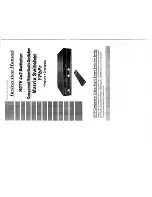
10
A path failure can cause spanning tree re-calculation to adapt the spanning tree structure to the
change. However, the resulting new configuration BPDU cannot propagate throughout the
network immediately. If the newly elected root ports and designated ports start to forward data
immediately, a temporary loop will likely occur.
The newly elected root ports or designated ports must go through the listening and learning
states before they transit to the forwarding state. This requires twice the forward delay time and
allows the new configuration BPDU to propagate throughout the network.
•
Hello time
The device sends configuration BPDUs at the hello time interval to the neighboring devices to
ensure that the paths are fault-free. By default, the hello time is 2 seconds. If the device does
not receive configuration BPDUs within the timeout period, it recalculates the spanning tree.
The formula for calculating the timeout period is timeout period = timeout factor × 3 × hello time.
•
Max age
The device uses the max age to determine whether a stored configuration BPDU has expired
and discards it if the max age is exceeded. By default, the max age is 20 seconds. In the CIST
of an MSTP network, the device uses the max age timer to determine whether a configuration
BPDU received by a port has expired. If it is expired, a new spanning tree calculation process
starts. The max age timer does not take effect on MSTIs.
If a port does not receive any configuration BPDUs within the timeout period, the port transits to the
listening state. The device will recalculate the spanning tree. It takes the port 50 seconds to transit
back to the forwarding state. This period includes 20 seconds for the max age, 15 seconds for the
listening state, and 15 seconds for the learning state.
To ensure a fast topology convergence, make sure the timer settings meet the following formulas:
•
2 × (forward delay – 1 second)
≥
max age
•
Max age
≥
2 × (hello time + 1 second)
About RSTP
RSTP achieves rapid network convergence by allowing a newly elected root port or designated port
to enter the forwarding state much faster than STP.
RSTP protocol frames
An RSTP BPDU uses the same format as an STP BPDU except that a Version1 length field is added
to the payload of RSTP BPDUs. The differences between an RSTP BPDU and an STP BPDU are as
follows:
•
Protocol version ID
—The value is 0x02 for RSTP.
•
BPDU
type
—The value is 0x02 for RSTP BPDUs.
•
Flags
—All 8 bits are used.
•
Version1
length
—The value is 0x00, which means no version 1 protocol information is
present.
RSTP does not use TCN BPDUs to advertise topology changes. RSTP floods BPDUs with the TC
flag set in the network to advertise topology changes.
Basic concepts in RSTP
Port roles
In addition to root port and designated port, RSTP also uses the following port roles:
Summary of Contents for S6850 Series
Page 108: ...48 WGE1 0 3 32768 49153 50100 0x7b 0001 0001 0001 ACDEF...
Page 259: ...21 6 N A 200 6...
Page 337: ...ii...
















































